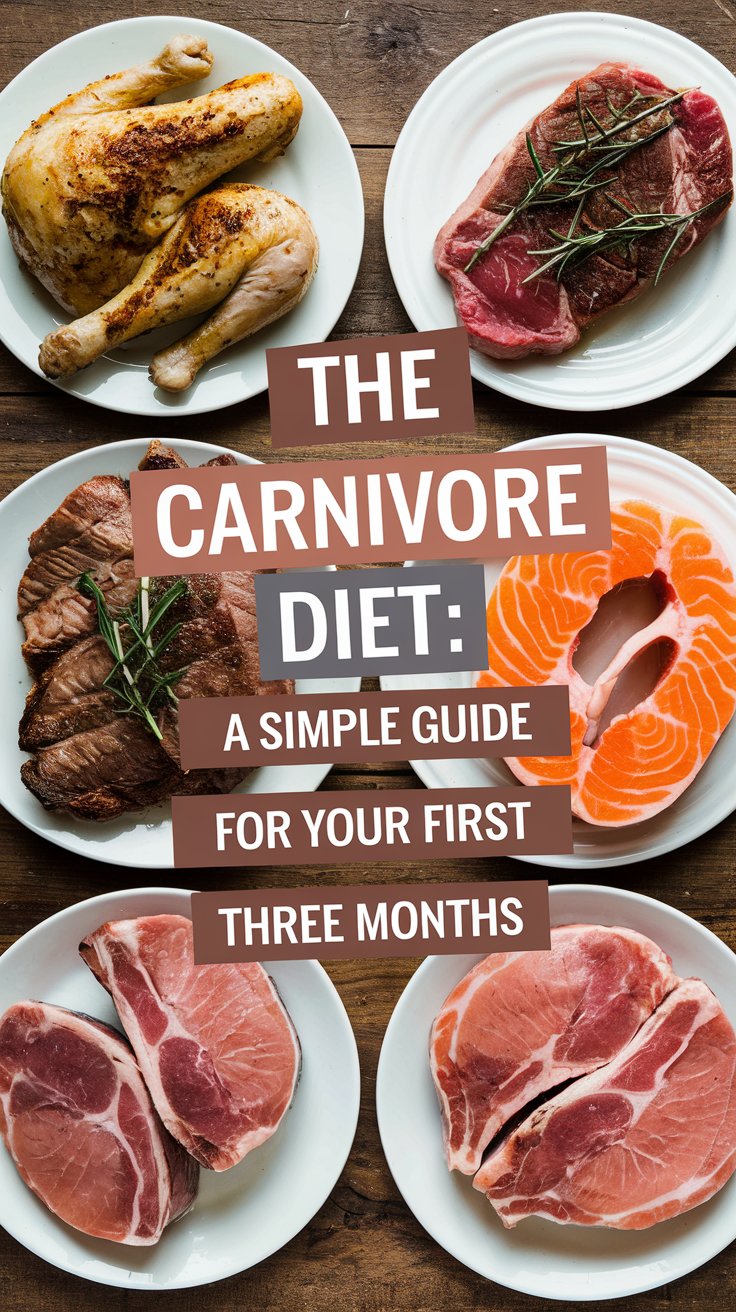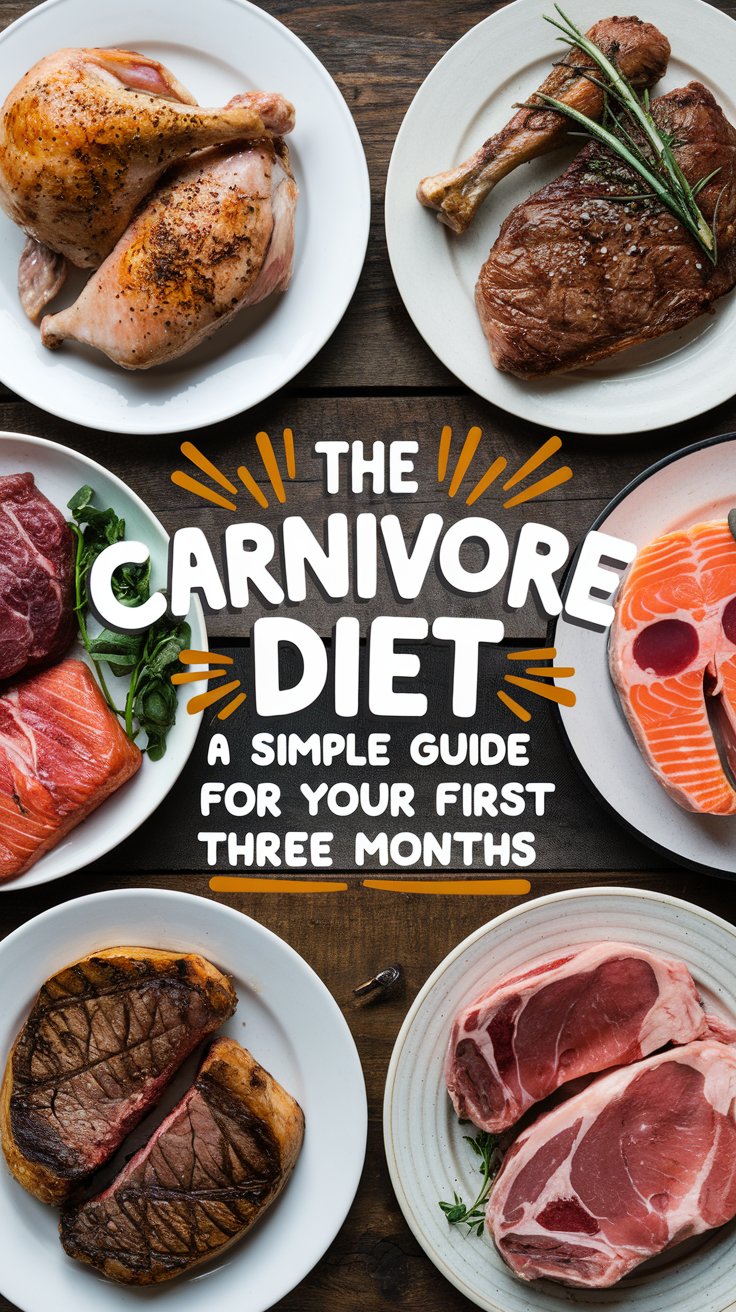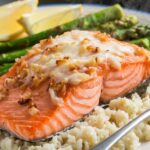
Please note: This website contains affiliate links. As an Amazon Associate, we earn from qualifying purchases at no additional cost to you.
Have you ever thought about eating only meat?
The Carnivore Diet is a way of eating where you only consume animal products. That means meat, fish, eggs, and sometimes dairy.
You don’t eat any fruits, vegetables, or grains. It might sound a little strange, but some people find it simple and satisfying. They also believe it can be a healthy way to eat.
This article will guide you through everything you need to know for your first three months on the Carnivore Diet, which is also called a meat-based diet.
This is a “meaty” article, so here are some shortcuts to the different topics we will cover:
- What Exactly is the Carnivore Diet?
- Key Rules of the Carnivore Diet
- Carnivore Diet Food List
- Preparing to Start the Carnivore Diet
- How to Eat on the Carnivore Diet
- Navigating the Initial Adaptation Phase (First Month or Two)
- Staying on the Diet Long-Term
- Carnivore Meal Planning and Recipe Ideas
- Frequently Asked Questions
Prefer to listen to this article?*

What Exactly is the Carnivore Diet?
The Carnivore Diet is all about eating animal products. This includes meat, like beef, chicken, and pork; fish, like salmon and tuna; and eggs. Some people also include dairy, like butter and cheese. The main idea is to cut out all plant-based foods. That means no fruits, vegetables, grains (like bread and rice), nuts, or seeds.
Some people who follow this diet believe that humans were originally meant to eat meat. They think that by removing carbs and plant-based foods, you can reduce swelling in your body, keep your blood sugar steady, and improve your health.
The Carnivore Diet is similar to the paleo diet, but more limited, and is like a very low carb or keto diet. The meat and fruit diet is not considered a carnivore diet.
Key Rules of the Carnivore Diet
Here are the basic rules of the Carnivore Diet:
- Eat only animal products.
- Avoid all plant-based foods.
- Drink water or zero-carb drinks like black coffee or tea.
- Some people include spices, coffee, and honey on a more relaxed version of the diet.
Carnivore Diet Food List: What Foods to Eat
Here are some foods you can eat on the Carnivore Diet:
- Meats: Beef (like ribeye and ground beef), lamb, pork (like bacon and pork chops), veal, and game meats (like venison)
- Poultry: Chicken, turkey, and duck
- Fish & Seafood: Salmon, sardines, shrimp, crab, and lobster
- Organ Meats: Liver, heart, kidneys, and tongue (these are full of nutrients)
- Eggs: Whole eggs from chickens, ducks, or quail
- Animal Fats: Beef tallow, lard, duck fat, ghee, and butter
- Bone Broth: Beef or chicken bone broth
- Dairy (optional): Heavy cream, hard cheeses, cream cheese, and butter
Preparing to Start the Carnivore Diet
Before you start, there are a few things you should do:
- Take Measurements: Weigh yourself and measure your chest, waist, and hips. You can also get a dexa scan and blood work done for more data.
- Clear Out Your Kitchen: Remove all non-carnivore foods from your kitchen, especially anything you know is a “weakness” for you.
- Go Grocery Shopping: Get a grocery list for the carnivore diet. Focus on things like eggs, ground beef, chicken, pork, butter, and bacon. Try to find discounted meat.
- Prep Some Meals: Cook some easy meals ahead of time like boiled eggs, burgers, and bacon.
- Find a Partner: Doing the diet with someone else can make it easier.
How to Eat on the Carnivore Diet (Without Losing Your Mind)
Transitioning to the Carnivore Diet may feel like stepping into the culinary wild west, but don’t worry—it’s simpler than you think! Here’s your roadmap to dining like a pro while keeping things tasty, sustainable, and satisfying.
Starting Strong: Setting Yourself Up for Success
Try “Priming”
Think of priming as the Carnivore Diet’s warm-up stretch. For the first 2-4 weeks, eat three meals a day, focusing on eating until you’re comfortably full. This gives your body a running start to adjust to this meat-focused lifestyle.
Don’t Force Fasting
Longer meal intervals will come naturally over time. No need to force yourself into intermittent fasting right away—let your body ease into its groove without the pressure of a stopwatch.
Scheduled Meals Can Help
If hunger cues are playing hard to get (especially in the beginning), consider scheduling your meals. It’s like giving your body a cheat sheet until it figures out the rules of this new game.
Eating Like a Carnivore: The Basics
Eat Until You’re Full
Forget calorie counting or leaving half your plate untouched. On Carnivore, the rule is simple: eat until you’re comfortably full. Think satisfying, hearty portions that fuel you without sending you straight to nap town.
Wait Until You’re Hungry
Here’s a revolutionary concept: don’t eat if you’re not hungry. Listen to your body and wait for true hunger cues instead of sticking to rigid meal schedules.
Learn to Recognize True Hunger
Is that your stomach growling or just boredom whispering sweet nothings? The Carnivore Diet helps you distinguish real hunger from emotional or habitual eating—spoiler alert: it’s not always snack o’clock.
Fine-Tuning Your Routine
At first, you might eat one, two, or even three meals a day. Over time, your body will naturally settle into a rhythm that works for you—whether that’s two solid meals or one epic steak-fueled feast.
During the adjustment phase, you may need to eat even if you’re not particularly hungry. Think of it as keeping your engine running while your body learns the ropes.
Know that loss of appetite is temporary. A drop in appetite or food aversions can be common early on, but don’t worry—it usually resolves after the first month as your body adapts to its new normal.
How Much Should You Eat on the Carnivore Diet?
Eat Enough Meat
Guidelines suggest eating between 1 and 4 pounds of meat per day. It might sound like a lot, but your body will thank you for the nutrients. Plus, nothing says “satisfying” like a plate piled high with steak.
Prioritize Protein
Aim for 1 gram of protein per pound of your ideal body weight. If that sounds intimidating, starting with 0.6g or 0.8g per pound is perfectly fine. Remember, protein is your powerhouse.
Tracking and Snacking: The Extras
Consider Food Tracking
While tracking isn’t a forever thing, it’s worth logging your meals for at least a few weeks. This helps you understand your protein and fat intake, troubleshoot any issues, and figure out what works best for you.
Food tracking or journaling is also really helpful if you hit a weight loss plateau because it allows you to see exactly what you’ve been eating and how you may need to adjust your diet.
Snacking Isn’t Usually Necessary
One of the perks of the Carnivore Diet is feeling full after meals, so snacking isn’t usually needed. But if hunger strikes, reach for simple options like hard-boiled eggs or leftover steak—easy, satisfying, and on-brand.
Here’s a quick table to summarize how to eat on the carnivore diet:
| Key Eating Principle | Description |
|---|---|
| Eat Until Comfortably Full | Eat until you feel satisfied, not stuffed. |
| Eat When Truly Hungry | Wait until you feel true hunger before eating again. |
| Meal Frequency | Eat one, two, or three meals per day, depending on your hunger levels and preference. You may also need to schedule meals. |
| “Priming” | For the first 2-4 weeks, you can try “priming” where you eat three meals a day, until you are comfortably full. |
| Typical Daily Amount | Eat between 1 to 4 pounds of meat per day. |
| Eat Enough Protein | Eat enough protein each day, calculated based on your ideal body weight. |
| Don’t Skip Meals: | You may need to force yourself to eat, even if you aren’t hungry. |
| Potential Appetite Changes: | In the beginning many experience loss of appetite and food aversions, but this typically gets better. |
| Food Tracking | Consider tracking food, at least for a few weeks, to learn protein and fat composition of foods and how much you’re eating. |
| No Snacking | You should not need to snack, because you will be satisfied with your meals. |
With these tips, you’re officially ready to tackle the Carnivore Diet with confidence and maybe even a little swagger. Let the meat feast begin—and don’t forget to savor every bite!
Navigating the Initial Adaptation Phase (First Month or Two)
The first month or two on the Carnivore Diet can be tricky.
- “Keto Flu”: You might get the “keto flu”. This is like carbohydrate withdrawal and can cause fatigue, diarrhea, constipation, and other not-so-fun symptoms.
- Electrolytes: Drink electrolytes to help with the “keto flu”— this is SO IMPORTANT!!! You can use a product like LMNT, or mix salt with water.
- Rest: Make sure you rest when you need to, and don’t exercise too much in the first few weeks.
- Mouth Boredom: You might get tired of eating meat. Don’t worry, this will go away.
- Commitment: Try to stick with the diet for at least 30 days, but it’s best to aim for 90 days to really see the benefits.
- Strictness: Try your best to be very strict in the beginning.
Longer-Term Considerations
After the first couple of months, here are some things to keep in mind:
- Variety: The carnivore diet can become boring, so try different ways of cooking, like grilling or baking.
- Nutrient Deficiencies: You might not get all the vitamins and minerals you need, because you aren’t eating fruits and vegetables. Consider eating organ meats and a variety of animal products.
- Digestive Issues: Some people get constipated because they don’t have enough fiber.
- Social Issues: It can be hard to eat out or go to parties because the diet is so restrictive.
- Limited Research: There isn’t a lot of research about the long-term effects of the Carnivore Diet.
- Listen to Your Body: Pay attention to how you feel, and consider talking to a doctor.
- Your Journey Will Be Different: Your experience with the carnivore diet will be different than other peoples.
- Measure Your Progress: Be sure to measure your progress as an individual, and not against someone else.
- Adapt: Adapt your version of the diet to fit your specific situation and needs.
Here’s a table summarizing some longer-term considerations:
| Longer-Term Considerations | Description |
|---|---|
| Variety | The diet can be repetitive, so experiment with cooking methods. |
| Nutrient Deficiencies | You may miss out on essential nutrients. Include organ meats and a variety of animal products. |
| Digestive Challenges | Some people experience constipation due to lack of fiber. |
| Sustainability | Dining out and social gatherings can be challenging. |
| Limited Research | Long-term studies on the carnivore diet are limited. |
| Listen to Your Body | Adjust the diet based on how you feel, and consult with a healthcare provider. |
| Individual Journey: | Remember that your carnivore journey will be different than others. |
| Measuring Progress: | Be sure to measure your progress as an individual, and not against someone else. |
| Adapt the Diet: | Adapt your version of the diet to fit your specific situation. |
Meal Planning and Recipe Ideas
Here are some examples of meals you can eat on the Carnivore Diet:
- 10 Carnivore Diet Breakfast Recipes
- 35 Carnivore Diet Snack Ideas: Protein-Packed and Totally Satisfying
- 12 Carnivore Dessert Recipes: Indulge Guilt-Free!
Favorite Carnivore Diet Recipes
- Carnivore Chili
- Bacon and Chicken Casserole: A Carnivore Diet Comfort Food Recipe
- Carnivore Breakfast Bowl (eggs, sausage, and bacon)
- Carnivore Meatloaf: A Protein-Packed, Easy Recipe
- Carnivore Meatballs with Ricotta Cheese
- See more recipes
Carnivore Diet: FAQs
Here are some frequently asked questions about the Carnivore Diet:
1. Can I include dairy on the Carnivore Diet?
Yes, dairy is optional, but if you choose to include it, stick to full-fat, low-carb options like heavy cream, butter, or hard cheeses. Avoid anything with added sugars or hidden carbs, as they can slow your progress.
2. How do I deal with carb cravings?
Carb cravings are common in the beginning but will diminish as your body adapts. Stay hydrated, eat enough fat to stay satiated, and try sipping on bone broth or tea to distract yourself. Trust the process—those cravings won’t stick around forever!
3. Is the Carnivore Diet safe long-term?
The long-term effects of the Carnivore Diet are still being studied, but many followers report sustained benefits like improved energy and digestion. As with any diet, it’s essential to monitor your health and work with a doctor if you have concerns.
4. What beverages can I have on Carnivore?
Stick to water, black coffee, or tea. If you’re feeling fancy, sparkling water is generally fine—just check the label for plant-based “natural flavors” and steer clear of added sugars.
5. Do I need supplements on Carnivore?
Possibly. While the diet is nutrient-dense, you may benefit from supplements like magnesium, potassium, or vitamin D, especially if you experience muscle cramps or fatigue. Electrolytes can also help if you’re transitioning from a carb-heavy diet.
6. What’s the difference between strict and relaxed Carnivore?
- Strict Carnivore: Avoids coffee, tea, and spices, focusing solely on animal products.
- Relaxed Carnivore: Includes items like coffee, tea, and some seasonings to add variety. Both approaches can work—choose the one that feels sustainable for you.
7. Can I have honey or sweeteners on the Carnivore Diet?
Nope. Honey and most sweeteners are off-limits on Carnivore. They can trigger sugar cravings and derail your progress, even if they’re technically “natural.”
8. Is sparkling water allowed?
Plain sparkling water is usually fine, but double-check the label. Some brands sneak in plant-based flavors that aren’t Carnivore-friendly.
9. What’s the difference between Carnivore, Keto, and Ketovore?
- Carnivore: Focuses exclusively on animal products (meat, eggs, and dairy).
- Keto: A high-fat, low-carb diet that includes both animal and plant-based foods.
- Ketovore: A hybrid approach, primarily meat-focused but allows small amounts of low-carb plants.
10. Do I need to eat organ meats?
Organ meats are not required, but they’re highly nutrient-dense and can be a great addition to your diet. If liver isn’t your thing, you can skip it or try desiccated organ supplements.
11. Can the Carnivore Diet improve mental health?
Many people report better mental clarity, focus, and energy levels on Carnivore. By eliminating inflammatory foods and stabilizing blood sugar, this diet may give your brain the boost it needs.
Here’s a table summarizing these FAQs:
| Question | Answer |
|---|---|
| Is dairy allowed? | Dairy is optional; stick to full-fat, low-carb options. |
| How to handle carb cravings? | Stay hydrated, eat enough fat, and they will subside as you adapt. |
| Is it safe long-term? | Long-term effects are still being studied. |
| What to drink? | Stick to water, black coffee, or tea. |
| Do I need supplements? | Supplements like magnesium, potassium, or vitamin D may be helpful. |
| What is strict vs relaxed carnivore | Strict carnivores avoid coffee, tea, and spices, but relaxed carnivores may include them. |
| Is honey and sweeteners allowed | Honey and most sweeteners are avoided on the carnivore diet. |
| Is sparkling water allowed | Plain sparkling water is generally acceptable. |
| Carnivore vs Keto vs Ketovore | Carnivore is only animal products; Keto allows both animal and plant foods; Ketovore is primarily meat-focused with small amounts of low-carb plant-based foods. |
| Do I need to eat organ meats? | Organ meats are not required, but they are full of nutrients. |
| Are there Mental Health Benefits? | Many people report improved mental clarity, focus, and energy levels. |
Final Thoughts
The Carnivore Diet is a very simple way of eating that can be very satisfying. It involves eating only animal products and cutting out all plant-based foods. While it can have potential benefits, it’s important to focus on eating high-quality animal products and listen to your body.
It may not be the right way of eating for everyone, but if you are curious about getting started on the Carnivore Diet it, we hope this article provides all the information you will need for the first three months of your meat-filled journey!

* Voiceover version of this article was read by an AI voice, Rachel.
Please note: This website contains affiliate links. As an Amazon Associate, we earn from qualifying purchases at no additional cost to you.












